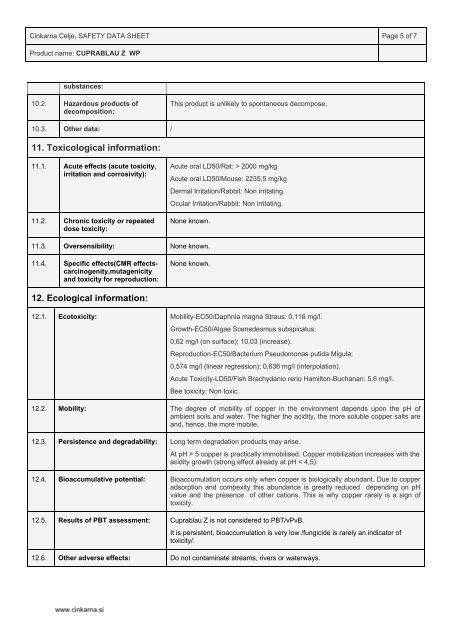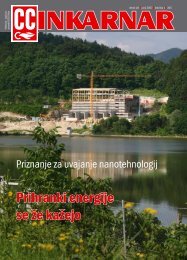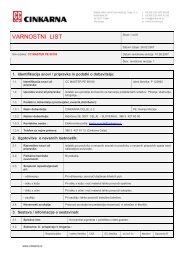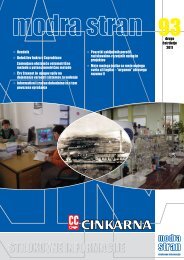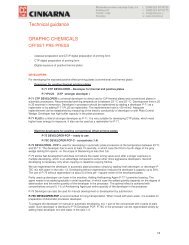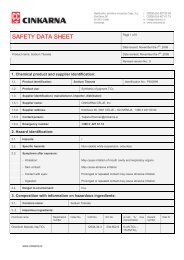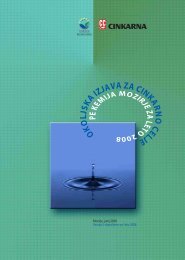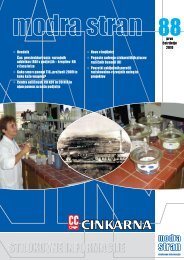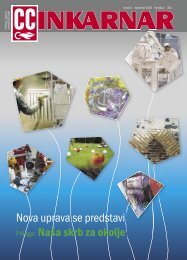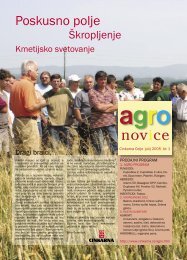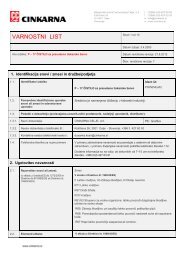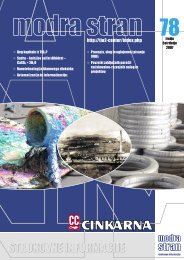Create successful ePaper yourself
Turn your PDF publications into a flip-book with our unique Google optimized e-Paper software.
<strong>Cinkarna</strong> <strong>Celje</strong>, <strong>SAFETY</strong> <strong>DATA</strong> <strong>SHEET</strong> Page 5 of 7<br />
Product name: CUPRABLAU Z WP<br />
substances:<br />
10.2. Hazardous products of<br />
decomposition:<br />
10.3. Other data: /<br />
11. Toxicological information:<br />
11.1. Acute effects (acute toxicity,<br />
irritation and corrosivity):<br />
11.2. Chronic toxicity or repeated<br />
dose toxicity:<br />
This product is unlikely to spontaneous decompose.<br />
Acute oral LD50/Rat: > 2000 mg/kg<br />
Acute oral LD50/Mouse: 2235,5 mg/kg<br />
Dermal Irritation/Rabbit: Non irritating.<br />
Ocular Irritation/Rabbit: Non irritating.<br />
None known.<br />
11.3. Oversensibility: None known.<br />
11.4. Specific effects(CMR effects-<br />
carcinogenity,mutagenicity<br />
and toxicity for reproduction:<br />
12. Ecological information:<br />
None known.<br />
12.1. Ecotoxicity: Mobility-EC50/Daphnia magna Straus: 0,116 mg/l.<br />
Growth-EC50/Algae Scenedesmus subspicatus:<br />
0,62 mg/l (on surface); 10,03 (increase).<br />
Reproduction-EC50/Bacterium Pseudomonas putida Migula:<br />
0,574 mg/l (linear regression); 0,636 mg/l (interpolation).<br />
Acute Toxicity-LD50/Fish Brachydanio rerio Hamilton-Buchanan: 5,6 mg/l.<br />
Bee toxicity: Non toxic.<br />
12.2. Mobility: The degree of mobility of copper in the environment depends upon the pH of<br />
ambient soils and water. The higher the acidity, the more soluble copper salts are<br />
and, hence, the more mobile.<br />
12.3. Persistence and degradability: Long term degradation products may arise.<br />
At pH > 5 copper is practically immobilised. Copper mobilization increases with the<br />
acidity growth (strong effect already at pH < 4,5).<br />
12.4. Bioaccumulative potential: Bioaccumulation occurs only when copper is biologically abundant. Due to copper<br />
adsorption and compexity this abundance is greatly reduced depending on pH<br />
value and the presence of other cations. This is why copper rarely is a sign of<br />
toxicity.<br />
12.5. Results of PBT assessment: Cuprablau Z is not considered to PBT/vPvB.<br />
It is persistent, bioaccumulation is very low /fungicide is rarely an indicator of<br />
toxicity/.<br />
12.6. Other adverse effects: Do not contaminate streams, rivers or waterways.


